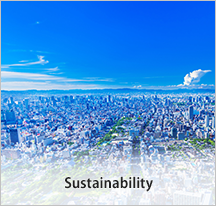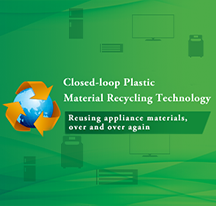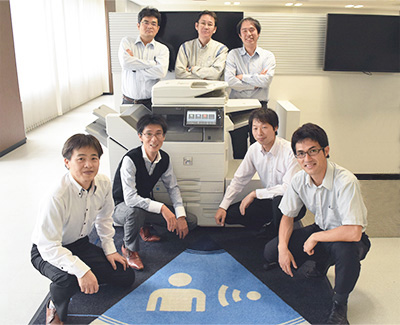
MX-6070N/5070N
Digital Full-Color MFPs
- Business Solutions BU, Office Solutions Business Unit
-
- Product Planning Division: Yuichiro Takesue (left, front, floor)
- Engineering Division II: Kosuke Namisaki (right, rear, floor)
- Engineering Division IV: Hiroki Kanemitsu (right, standing)
- Engineering Division V: Takeshi Okuda (center, standing)
- Engineering Division VII: Osamu Wada (right, front, floor)
- Systems Development Division III: Kazushi Yamaneki (left, rear, floor)
- Systems Development Division IV: Takahiro Kawakami (left, standing)
Note: Information is current as of September 1, 2016.
Welcome to "Always Thinking Green," a series where Sharp development personnel talk about Sharp's dedication to creating environmentally conscious products and the obstacles they have had to overcome.
In this issue, we speak with the seven members of the development team behind the MX-6070N/5070N digital full-color MFPs.
(Interview by "Always Thinking Green" editor)
MFPs have many useful functions like printing, scanning, and faxing.
Today, I've come to do a story on a newly developed and much-talked-about MFP.
Takesue (product planning):In these latest products, our focus was on environmental performance and ease of use. We'll talk about the MX-6070N/5070N digital full-color MFPs, whose functions "sense the user and save the environment."
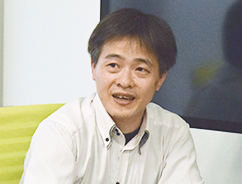
Former toner developer Mr. Takesue. He is currently in product planning.
By environmental performance of MFPs, do you mean saving paper? Come to think of it, I've never thought about how much electricity is consumed when I use an MFP. At home, though, all I think about is how to use less electricity and save on my electricity bills.
Takesue:That's exactly what I was going to talk about: saving electricity with MFPs. When you're not using the MFP, the power goes off, right? That's because the MFP is in sleep mode*1. Having the MFP in operational mode all day is a waste of electricity, so using the sleep mode is recommended. However, we had some customers telling us that it takes time from when the sleep mode release button is pressed until the control panel lights up.
- *1 Operations that consume the most electricity are temporarily turned off until they are needed, thus reducing energy consumption.

Pushing this button wakes the MFP up from sleep mode
Yes. When you push the button, you hear a noise of the MFP starting up, and you have to wait a while before you can use it. Environmental performance is great, but you don't want it at the expense of convenience.
Takesue:That's right. It's important that you have environmental performance without sacrificing ease of use. We wondered if there weren't some function we could create that would give users environmental performance as well as convenience.
So, we came up with the motion sensor featured on the new MFPs. A sensor detects when someone approaches the MFP and wakes it from sleep mode. That person has to wait less time to use the MFP.
Motion sensor: Ease of use and environmental performance
When someone reaches a preset distance from the MFP, it wakes up from sleep mode.
The motion sensor! I imagine MFPs as just sitting there waiting, but these ones actually spring into action by themselves. Wow!
Yamaneki (software development):That's not all. MFPs require warm-up time to use functions like copying and scanning. We therefore worked to shorten the warm-up time for scanning, a function that is being used more often recently. It now takes only one second to use the scanning function.
One second! That's incredible! What about the copying function?
Takesue:Copying requires the longest warm-up time of any MFP function. We had to do something about this or we couldn't solve the fundamental waiting time problem. So we asked the engineering division if they could possibly cut warm-up time in half.
Namisaki (copy fusing technology):We had always strived to shorten warm-up time, but we thought that cutting it in half would be impossible (laughs)! However, we wanted Sharp MFP customers to be able to use our products stress-free, so we decided to take on this challenge.
This is where engineers can show what they're really made of.
So, what exactly did you do?
Namisaki:First, let me talk about how the printing mechanism works.
A heated belt, called the fusing belt, is used to apply pressure to paper with toner on it, melting the toner and fusing it to the paper. Put simply, warm-up is the action of bringing the belt up to a temperature where fusing can take place. To be able to quickly heat up the belt, we developed the quick-heating belt fusing system.
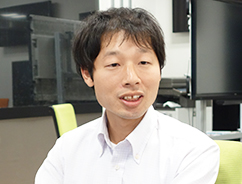
Mr. Namisaki, in charge of copy fusing technology, talked about the long road to developing the new technology
What exactly is the quick-heating belt fusing system?
Namisaki:The heat flows from the halogen lamp (1) to the fusing roller (2) to the fusing belt (3). To get the heat flowing more quickly to the belt, we made the roller's exterior wall thinner, thus improving the heat conductivity. We had previously struggled to make the roller thinner, but we had trouble ensuring its durability given the fact that it is constantly turning. We eventually used a new material for the roller and succeeded in making its exterior wall 80% thinner. We were so happy! And for the fusing belt, we adopted a new material that is effective at conducting heat.
Newly Developed Quick-Heating Belt Fusing System

Wada (toner development):Because the heat required for fusing is determined by the heat to melt the toner, we also strove to develop toner that can fuse at a low temperature.
However, if the melting temperature is too low, there's a chance that the toner being shipped to tropical regions will melt. So we tried to make it both heat resistant and able to melt when necessary. This was no easy task.
So, you were able to realize a shorter warm-up time by combining new developments in the fusing belt and toner?
Wada:That's right. Through cooperation among engineers in various fields, we were able to cut warm-up time in half, from 30 to 15 seconds*2. By the time you finish placing the original document in the MFP and inputting the number of copies, warm-up time is over. You can make copies with a minimum of waiting.
- *2 Comparison with MX-5141N, B&W copying (note that actual results will depend on environmental factors)
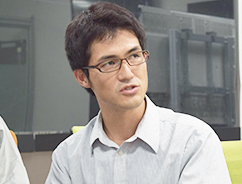
Mr. Wada developed the toner by studying heat resistance during usage, storage, and transportation

